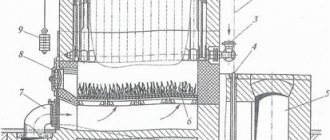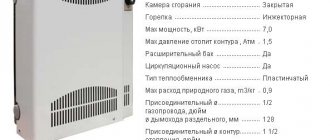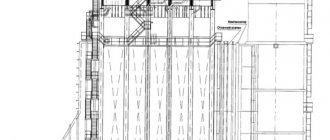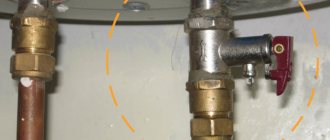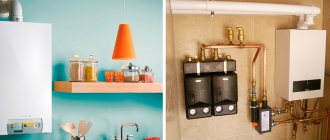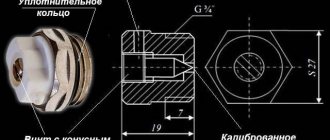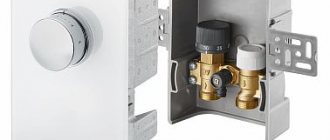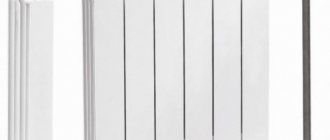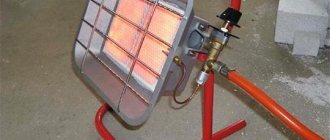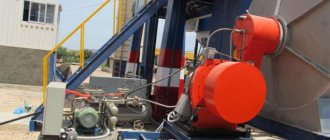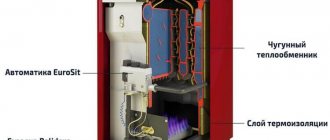General operating principle
At its core, a heat gun is a heat generator for heating rooms. In it, the air flow is heated by the combustion of liquid fuel. It consists of a cylinder with a built-in fan, a pump, a nozzle and a burner. At the very bottom is the fuel tank. The operating principle of a diesel heat gun is simple:
- From the tank, using a pump, fuel enters the nozzle;
- a flammable mixture begins to spread from the nozzle under pressure;
- fuel ignites in the chamber;
- the fan pumps air through the cylinder;
- at the exit we get a stream of highly heated air.
There are 2 types of diesel fuel heat gun:
- Direct heating heat generator.
- Indirect heating heat generator.
Kinds
Diesel heat guns are usually divided into two main options:
- direct heating units;
- indirect heating units.
Let's consider the principle of operation of each of these types of heat guns.
You may be interested in an article about electric heat guns.
Read an informative article about gas heat guns here.
Direct heating
The operating principle of a diesel heat gun consists of the following sequential actions:
- diesel fuel is supplied from the tank to a special filter for heating;
- with the help of a compressor, fuel is supplied to the nozzle;
- diesel fuel is ignited by a glow plug;
- the fan, which is located behind the burner, draws cold air into the combustion chamber, and thus heats it;
- the protective mesh located in front of the heat gun body delays the burner flame, preventing it from leaving the combustion chamber;
- heated air is directly supplied to its destination.
As you can see, the operating principle of a diesel heat gun with direct heating is quite effective and understandable.
But this type of unit has one significant drawback: along with the air heat flow, diesel fuel combustion products also enter the room.
In this regard, the following requirements are imposed on the use of diesel heat guns:
- It is prohibited to use this type of unit in residential buildings;
- the room where the heat gun operates must be equipped with a good ventilation system;
- Using a unit of this type, it is allowed to perform all work operations, without exception, in open areas.
Indirect heating
The operating principle of a heat gun with indirect heating is almost similar to the previous type.
However, a unit of this type has a significant advantage: waste combustion products are discharged outside the room through a specially equipped chimney. Thus, heat guns with indirect heating can be effectively used in residential premises, provided there is proper supply ventilation.
Direct heating heat generator
A direct heating diesel heat gun is not equipped with a chimney and has the simplest design. Therefore, direct-flow heaters are inexpensive, compact, easy to use and reliable. Ignition of the fuel occurs using a spark plug, in some models - from an electric spark gap. The heated stream of air, along with the exhaust gases, enters the building that needs to be warmed up.
The use of such a heater is only possible in non-residential buildings with a good ventilation system or on construction sites (open).
Below is shown the design of a diesel installation using the direct heating method.
About Master direct heating diesel guns
Diesel heat guns Master series “B” is a line of direct heating heaters that supply warm air with combustion products.The main advantage of Master direct heating diesel heat guns is their efficiency, which is actually 100%. The fuel in such guns burns completely and gives off all the heat directly to the air. The power of such heat guns reaches 111 kW. Thanks to this, these guns can heat large rooms, both closed and semi-open. Low fuel consumption and a large fuel tank allow you to maintain continuous operation of a direct heating diesel heat gun for 10-16 hours.
Application of direct heating heaters.
These Master air heaters are used for heating, defrosting and drying, both outdoors and in constantly ventilated rooms. Master b 360 heat guns are heat generators designed in accordance with modern safety standards, performance standards and living standards, durable, reliable, and environmentally friendly. The Master diesel heat gun can be equipped with wheels for ease of movement.
There are great benefits to installing a thermostat. The thermostat allows you to maintain the desired temperature in the room. Depending on the air temperature, the heat gun can turn itself off and on.
The limitation in using diesel heat guns Master direct heating is the need for an influx of oxygen to maintain the combustion of the flame. Therefore, they require an influx of fresh air to operate. The use of direct heating heaters is prohibited indoors, since during operation, direct heating diesel heat guns emit combustion products into the heated room. When using direct heating guns, it is also necessary to adhere to the instructions that describe the air exchange parameters.
Such heaters are most effective for use in open and semi-open spaces, for example on construction sites or in agriculture.
Indirect heating heat guns are suitable for heating enclosed spaces where people work.
Ventilation requirements
There must be at least 2800 sq. cm (3 sq. ft.) of fresh outside air intake area for every 29 kW of non-heater rated power. When using multiple heaters, additional fresh air is required. Example. To operate the Masert B 150 CED heat gun with a power of 44 aW, it is necessary that: • the door of a double garage is raised by 15 cm (6 inches) • the door of a single garage is raised by 23 cm (9 inches) or • two windows 76 cm (30 cm) high in) were raised 31 cm (12 in)
Design and principle of operation of Master heat guns with direct heating.
Fuel supply system. Under the action of the air pump, air moves through the air duct and passes through the burner nozzle, causing the fuel to rise from the tank. Atomized fuel is injected into the combustion chamber.
Air supply system. The electric motor rotates the fan, under the influence of which air moves in and around the combustion chamber. When heated, it forms a stream of clean hot air at the outlet.
Ignition system. The electronic direct fired diesel heat gun supplies voltage to the spark plug. The spark plug ignites the fuel-air mixture.
Flame control system . This system turns on the heater if the flame goes out.
Scheme of work. 1. Combustion chamber 2. Flue pipe coupling 3. Burner 4. Nozzle 5. Electric valve 6. Fuel line 7. Fan 8. Motor 9. Fuel pump 10. Cable winder 11. Fuel tank 12. Control panel
Electrical panel 1. Restart button 2. Socket for outdoor thermostat 3. Heater button 4. Power cord 5. Voltage indicator.
Safety information when working with MASTER direct-heating diesel heat guns
Indirect heating heat generator
A diesel heat gun of indirect heating is used in all cases as direct flow. But due to the fact that gases are vented outside, the range of its application expands significantly:
- in construction;
- agriculture;
- Ministry of Emergency Situations;
- in production workshops;
- for drying plaster (putty) during the cold season;
- heating concrete;
- drying facades during facing work;
- for warming trenches;
- heating greenhouses, livestock farms;
- heating residential premises and other things.
The design of diesel heat guns with exhaust gases contains a closed chamber in which fuel burns and a chimney. Fuel is supplied under pressure to the nozzle, in the chamber it is sprayed in the form of an aerosol and ignites. Air is pumped inside the unit by a fan. To maintain the combustion process, part of the air enters the chamber through holes located at the rear. The rest of the flow moves between the heater casing and the combustion chamber, where it is heated. Smoke exits the chamber through the chimney and is discharged outside, bypassing the room.
The use of such diesel heat guns is permitted for heating garages, rooms with people in them, and pavilions. But during the operation of the heater, oxygen burns out, so ventilation must be provided to compensate for its loss.
Characteristics and design of a heat gun
One of the main technological parameters of heat guns is power, fuel consumption and air supply volume. As for power, this is an indicator of the average corridor from 10 to 80 kW. For rooms where people live, they buy guns with a power of 10 to 25 kW. For industry, guns with a power of about 200 kW are purchased.
In order to save money, it is necessary to take into account the volume of fuel with which the heat gun operates. Fuel consumption averages 6 liters per hour.
The greater the power of the fan heater, the more fuel it consumes.
The power of a solar heater is selected depending on the area that needs to be heated. Such a device can be from 200 to 3000 m3/h. For a residential premises, an installation with an initial volume value will be sufficient, but warehouse-type premises and construction sites are already served by heat guns with high productivity.
How does a diesel gun differ from other models? It can run on gasoline or diesel fuel, there is an electrical installation that includes an electric motor and a design with a gas installation completes this list. But what these items have in common is that they are all explosion-proof and not resistant to water.
Multi-fuel heat generators
A liquid fuel heat gun can also be multi-fuel. This means that the unit is capable of operating on waste oil, gasoline, diesel fuel, and kerosene. Often this type of heater is used in places with a sufficient amount of petroleum products and their waste. These could be: fuel warehouses, car parks or car services. At the same time, the problem of recycling waste fuel and lubricants is solved and heating is free.
The figure below shows the operating diagram of a multi-fuel generator.
Characteristics of the Inforce DHG 20 D direct heating gun
This equipment can be purchased for RUB 10,900. It is a device with stable flame combustion and multi-level protection. The design is durable and can maintain a certain temperature. The device operates economically and consumes about 360 W, which is used to power the fan and automation.
Fuel consumption per hour is about 2 liters. Air is consumed over the same period of time in a volume of 620 cubic meters. A power plug is included. This diesel fuel heat gun weighs 18 kg. The efficiency is 100%. The tank holds 24 liters. When heating, the power reaches 20 kW. Power consumption is 180 W.
Diesel infrared guns
The liquid fuel infrared heat gun heats large rooms with high efficiency and at the same time efficiency. It can also be successfully used outdoors. This type of heat generator heats the very objects towards which it is directed. Heating of the air occurs from objects heated by the rays, and the height of the ceilings in the room does not play a significant role. Due to these characteristics, significant fuel savings are achieved.
Using this property, it is convenient to spot heat objects in the open air.
How to choose a heat gun
There are a few important things to consider before choosing a heat gun.
- Unit form. Thermal liquid fuel heaters can have a rectangular or cylindrical shape. Due to the large area of air flow distribution, rectangular ones can be used as the best option during indoor construction work.
For spot heating of objects or areas in a room, a cylindrical gun is more suitable.
- Mobility. Portable units are very convenient to use, they are easy to carry, some models are equipped with trolleys. Stationary units are used for constant heating of areas. When installing them, special installation work is required.
Stationary type gun
- Heating method. The air flow can be heated directly or indirectly. This is important if the heater will be used in rooms with people or animals.
- Types of fuel used. The combustible mixture should be selected based on specific situations and the rationality of its use.
- Noisy. Some heat guns (high power) using diesel fuel are not recommended for use in small rooms due to the noise they make.
- Unit power. This parameter should be taken into account first of all before choosing a diesel heat gun. The quality of heating the room or drying it depends on it. Information about the power of the device can be found in its description.
Most heat guns have a temperature control knob that allows you to adjust the operation of the unit to a set room temperature, after which it turns off. The device does not turn on if the temperature on the display is set lower than in the room. Diesel heaters are also equipped with a protection system against overheating.
Diesel heat gun, price
Diesel heat gun, its price does not always correlate with quality. The best choice is the model with the maximum power. You may have to overpay in this case, but it will be justified:
• if there is excess heat, there will be no problems with reducing the intensity of the thermogenerator’s operation, including if it is necessary to heat another room that is smaller in area; • lack of heating power will force you to purchase additional equipment of this type, and this will lead to even higher costs compared to what you would have to spend on a maximum power model.
You should also consider the installation location of the diesel heater, the efficiency of its operation depends on this.
If you need to purchase a heat generator, we can help you calculate and choose the best option! +7 (495) 532-25-70
How is the power of a heat gun calculated?
The thermal power of the device is calculated by the formula: V * T * K = kcal/h, where:
- V – volume of the room (width * length * height), in m3;
- T – difference between outside and indoor temperatures, in degrees Celsius;
- K – thermal dissipation coefficient.
For different types of premises the coefficient values are set:
- from 3.0 to 4.0 - a room in which thermal insulation is not provided, for example, a structure made of wood or sheet metal;
- from 2.0 to 2.9 - a room with poor thermal insulation. A simple building with one brick masonry;
- from 1.0 to 1.9 – a building with an average level of thermal insulation (2 bricks and several windows, standard roof);
- from 0.6 to 0.9 – a building with high quality thermal insulation. Brick structure with double insulation. Double glazed windows. The base under the floor is of sufficient thickness. High quality material was used on the roof for insulation.
An example of calculating the power of a diesel heat gun:
- V = 150 m3;
- T = 29° C (outside temperature -10° C, required indoors +19° C, the difference will be - +29° C);
- K = 2 (building with one brick masonry);
We substitute the data into the formula: 150 * 29 * 2 = 8700 kcal/h, despite the fact that 1 kWh = 860 kcal/h. This means: 8700 / 860 = 10.116 kWh. Thus, we learned that to warm up this building, a liquid fuel heat gun with a minimum power of 10 kWh is required. It is recommended to buy a unit with some power reserve.
Advantages of diesel heat generators
There are several positive aspects when using diesel heat guns:
- excellent performance characteristics;
- ease of maintenance;
- power can reach up to 230 kW;
- very low fuel consumption;
- battery life more than 10 hours;
- works well at low temperatures;
- the ability to quickly heat large areas.
Based on the above positive aspects, we can say with confidence that a heat gun is the most effective device for heating residential and industrial premises.
